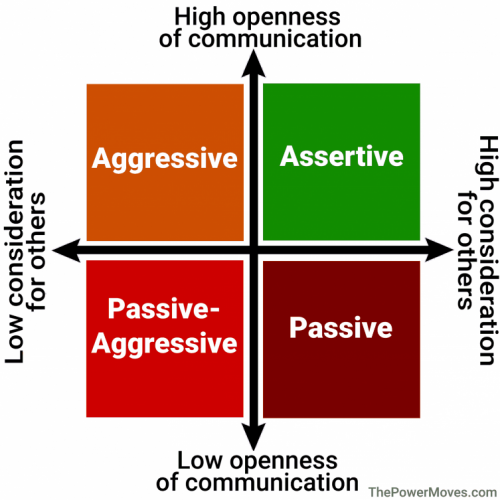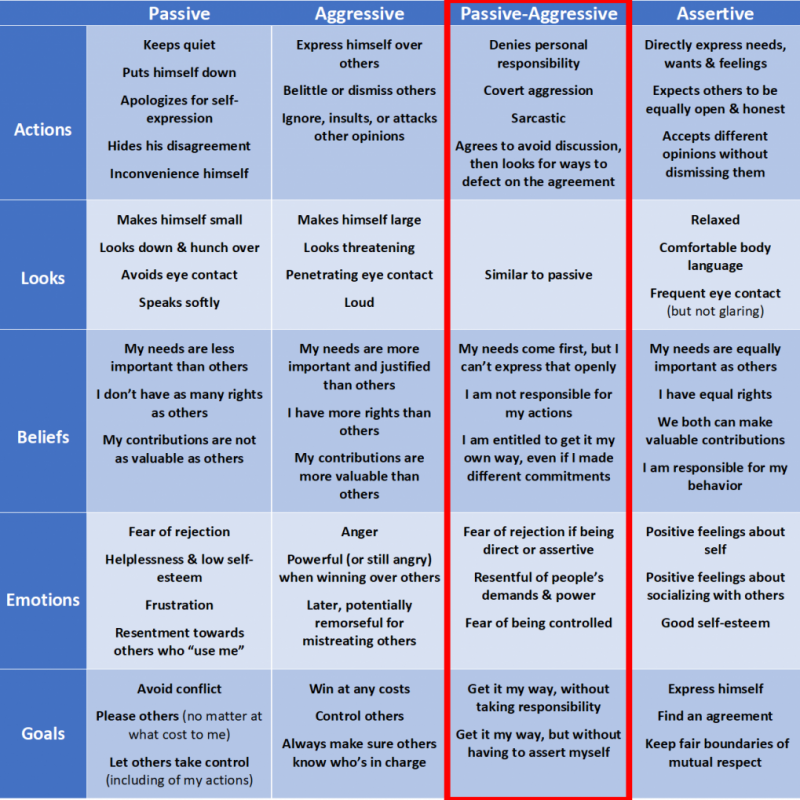As leaders, effective communication is our bread and butter.
Through trial and (sometimes many!) errors, we learn how to communicate more effectively. Alongside this, we are also supporting our colleagues to develop their ability to communicate more effectively. This can be both rewarding, and emotionally taxing.
There are four major types of communication:
One area that can cause much angst for leaders is managing passive aggressive behaviour.
So what does passive-aggressive behaviour look like?
People who use this form of communication will often:
- Deny or repress feelings of anger.
- Use brief, deflecting responses such as “I’m fine” and “Whatever” when someone asks them if they are upset.
- Withdraw and sulk.
- Use the silent treatment.
- Create minor but chronic irritation in others.
- Be overtly cooperative but covertly uncooperative.
- Procrastinate or carry out tasks inefficiently.
- Be evasive and secretive.
- Use email, texting, social media, and other forms of technology to avoid direct communication.
- Project angry feelings on others.
- Cast themselves into the role of victim of an overtly angry person.
- Be quietly manipulative and controlling.
- Cause others to swallow their anger and eventually blow up.
- Make endless promises to change.
- Create a feeling in others of being on an emotional roller coaster.
- Undermine others
- Use ambiguity and avoid taking responsibility
- Do less than agreed, do it late or do it sloppily
- Negativity (pouting, resisting influence or creating arguments)
- Withholding important information
- Frenemy-type of behavior (back-stabbing)
- Backhanded compliments (Not bad for someone with your skills)
- Microaggression or covert aggression & covert power moves
In context, it may come across in comments and behaviours such as:
- “Well, I guess I’m not important enough to be invited”
- “We’re not in the “A” team.
- “Can you please help me with this, because … doesn’t have time for me”.
- “When were you intending on telling us about that?”.
- Avoiding eye contact, and “the silent treatment”.
- Saying ‘yes’, then doing nothing, repeatedly.
The chart below shows what it looks like in relation to other forms of communication.
How might we manage this type of behaviour?
Key to managing passive-aggressive behaviour is first recognising it, and not leading, or mirroring (copying) it.
Behavioural psychologist, William Glasser stated that “All behaviour is a form of communication”. Our role as leaders is to support people to communicate their needs more effectively, and it begins with turning the mirror towards ourselves first.
One method in addressing passive-aggressive behaviour is “Benign Confrontation”. This includes calling out the behaviour for what it is.
“It seems to me that you’re angry…”
You don’t need to know why they are angry, you are drawing attention to the underlying feeling that may be there.
Should they respond with denial “No I’m not”, then a response such as “It’s just a thought I wanted to share with you, and I’m glad it’s not the case”.
Should they wish to address their anger, then activate your active listening skills to identify the source, and renegotiate a new way of operating, or restate expectations.
Finishing with a genuine conciliatory closing statement such as “I’m looking forward to working alongside you on this” will confirm that you are ready to continue the relationship on a different footing.
I also invite you to reflect on your own communication:
- Which quadrant does it sit in and with who?
- Why might that be?
- How might others experience your communication?
Go well 🙂
MA




Touche. Sound arguments. Keep up the amazing effort.
Leave a comment